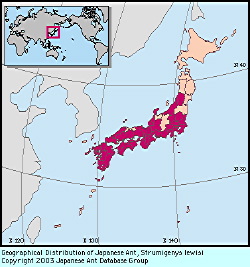
|
species
|
Strumigenys lewisi
|
 |
Original Reference
|
|
Cameron, P. (1886) On a new species of Strumigenys (S. lewisi) from Japan. Proceedings of the Manchester Literary and Philosophical Society 25: 229-232.
|
Synonym
|
|
Strumigenys godeffroyi var. lewisi Mayr (Mayr, 1887) ,
Strumigenys lewisi Brown (Brown, 1949) ,
|
Description
|
|
Total length of workers around 2 mm. Body color yellow to brown. Outer margin of mandibles feebly convex in full-face view; apical fork with 2 or 3 small intercalary denticles. A subapical tooth present on each mandibular shaft, each as long as the space between the mandibular shafts. Standing hairs on mesosoma not abundant, numbering only 4 to 8. Dorsal outline of mesosoma only weakly interrupted by metanotal groove, which is shallow. Spongiform lamella developed below propodeal spine. Most parts of mesothorax and propodeum unsculptured, smooth and shining.
|
Remarks
|
|
Very similar to Strumigenys sp. 4 and Strumigenys sp. 9. It can be difficult to separate the workers, but S. lewisi is marked by its females, which have the mesonotum relatively low, and have relatively small posterior ocelli and eyes. Nests are found under stones or logs, in the soil, decayed stumps or bamboo stems. Winged forms appear in August. Details of predatory behavior were reported by Masuko (1984, 1985). The workers prey on Collembola (Okamoto, 1953, Masuko, 1984). Colonies are small, usually with between tens and 100 workers (Teranishi, 1929). The species is polygynous. It is one of the most common soil-inhabiting ants of Japan. Most former records of "S. lewisi" probably involved Strumigenys species 4 or Strumigenys species 9 of this account, and thus need reassessment.
|
|

Distribution
|
|
Honshu, Shikoku, Kyushu, Tsushima I., Yaku I.; Mainland China, Korean Peninsula, Hawaii, India, Sri Lanka, Myanmar.
|
|
References
|
|
- Masuko, K. (1984). Studies on the predatory biology of Oriental dacetine ants (Hymenoptera: Formicidae) I. Some Japanese species of Strumigenys, Pentastruma, and Epitritus, and a Malaysian Labidogenys, with special reference to hunting tactics in short-mandibulate forms. . Ins. Soc., 31, 429-451.
- Masuko, K. (1985a. ). Hunting of Collembola by dacetine ants. . Insectarium, 22, 4-9. .
- Okamoto, H. (1953). Ants from Shikoku, Japan (2). . Gensei,, 2, 39-43. .
- Teranishi, C., 1929
|
Editor
|
|
Original text by Kazuo Ogata, Keiichi Onoyama and Mamoru Terayama. English translation by Kazuo Ogata, edited by Robert W. Taylor. Revised by Masashi Yoshimura.
|
|